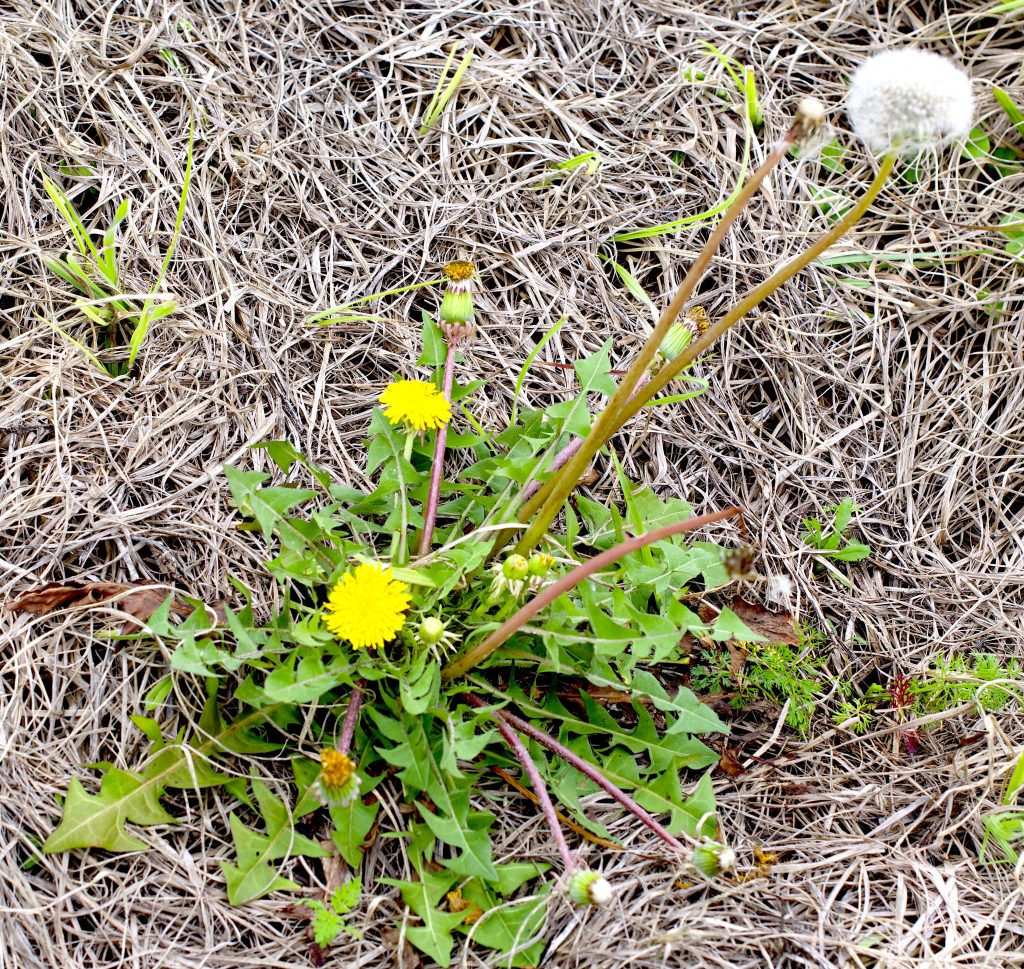
Dandelions are sporadic locally. Photo by Green Deane
Dandelion blossoms, ten pounds of sugar, and two cakes of bread yeast became my first batch of wine. I was in grammar school at the time but an old hand by then having already made two five-gallon batches of beer out of cooking malt. The wine came out far better than the beer which was made in a five-gallon crock in the basement. (I had to use an oil lamp under it to keep it warm enough to ferment in the winter.) Back then all soda bottles took a cap and we had a capper for making homemade root beer. Thus most of the beer and later the wine went into 16-ounce used Coca-Cola bottles. I can remember one of our neighbors — a Mr. Gowen — getting quite drunk on that Dandelion wine one night. To an 8th grader that was success.
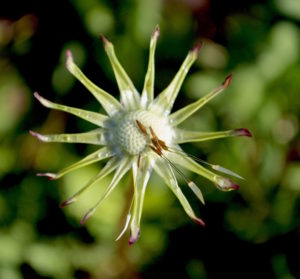
Dandelion after all the seeds have floated away. Photo by Green Deane
The Dandelions I used were huge with blossoms nearly two inches across. They grew in large colonies so it took very little time to collected several pounds of them (and one had the greens for supper.) Unfortunately that is not possible here in warm Florida. Dandelions hate hot weather which is why this abundant northern blossom is seen sporadically during our winter, and then often an anemic version of the real thing. Look around oaks in our cooler months. Dandelions are, of course, not only prime food but medicine as well. If you want to know more about them and a wine recipe you can go here.
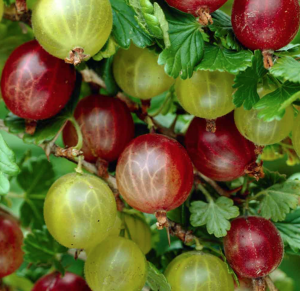
Gooseberries come in several colors.
You won’t find wild Gooseberries or currants anywhere near The South. They like cool, humid weather: Think New England, Nova Scotia, Newfoundland, New Brunswick and west of there (and also possibly the tops of the Appalachian Mountain Chain.) There were several “blights” in the last century. One took out the American Elm and another the great Chestnut. A third took its toll on Gooseberries. They did not get the disease themselves, the White Pine Blister, but they were the intermediate host of the disease. As one might imagine a pine blister in the the Pine Tree State was serious business thus Gooseberries and currants had to go. Legions of Boy Scouts and WPA workers destroyed it where they found it. But, I do remember seeing them in the wild. We often rode horseback over abandoned woods roads where there were also abandoned farm houses. There I saw Gooseberries and currants self-seeding. A ban on the plants was federally imposted in 1911 then shifted to the states in 1966. You can harvest Gooseberries now here and there at picking farms and no doubt there are some wild one still. You can read about Gooseberries here.
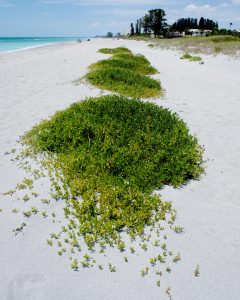
Sea Purslane mounds. Photo by Green Deane
Sea purslane is not seasonal but it does favor the spring by putting on a lot of new shoots. By the time autumn falls the plant has been isolating salt from the water which turns its stems red. Thus one uses green stems as greens (boiled, roasted or stuffed in a fish or the like you are cooking) and the red stems for salt or seasoning. The older stems also get a woody core so one usually does not eat them. Young greens can be tossed right on the grill and wilted for a wonderful flavor. Sea purslane will also happily grow in your non-salty garden. It competes successfully in salty areas but does not have to be in salty ground. If you grow it at home it is not salty. To read more about sea purslane go here.

Classes are held rain or shine or cold. (Hurricanes are an exception.) Photo by Kelly Fagan.
Foraging Classes: Heading north for Saturday’s class, dress warmly as Gainesville will be dipping into the low 50’s.
Saturday November 6th, Boulware Springs Park, 3420 SE 15th St., Gainesville, FL 32641. Meet at the picnic tables next to the pump house. 9 a.m. to noon.
Sunday November 7th, Blanchard Park, 10501 Jay Blanchard Trail, Orlando, FL 32817. 9 a.m. to noon, meet by the tennis courts. Remember this is time-change weekend.
Saturday November 13th, George LeStrange Preserve, 4911 Ralls Road, Fort Pierce, FL, 34981. The preserve is only about three miles from the junction of the Turnpike and I-95. It has no bathroom or drinking water so take advantage of the various eateries and gas stations near the exit.
Sunday November 14th, Mead Garden: 1500 S. Denning Dr., Winter Park, FL 32789. Meet at the bathrooms. 9 to noon. The park entrance is on South Denning. Some GPS directions get it wrong.
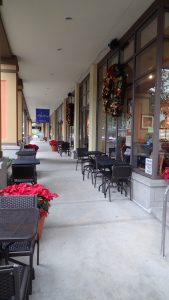
Panera’s in Winter Park where we start and finish the Urban Crawl.
My annual Urban Crawl is coming up, my twelfth, on Frkiday, December 17th. A reasonable question is what about foraging in a city? There is some surprising research. Dan Brabaner is a geoscience professor at Wellesley College, Boston. With some undergraduate students they studied preserved food collected from fruit trees and the like in the urban Boston area. What they found was cherries, apples, peaches and herbs were relatively low in lead and arsenic. That is, a serving had less amounts of these toxins than the allowed daily amount for a child. The team also did not find a significant difference between peeled and unpeeled fruit. The fruit was low in toxic chemical because they are the furthest away from any toxins in the soil. This would apply to tree nuts as well. Leafy greens faired well, too, because they grow fast and 1) don’t have time to accumulate toxins and 2) most air pollution on them can be washed off. Brabander also analyzed foraged food from plants growing in the urban environment not growing on agricultural soil. These foods had higher micronutrients because they were not growing on worn-out agricultural soil. Calcium and iron were higher as were manganese, zinc, magnesium and potassium. Thus we know that not only do “weeds” pack more of a nutritional punch because they are wild but also because they can be growing in better soil. My Urban Crawl is a free class We meet in front of Panera’s at 10 a.m. We wander south to the college, stop at Starbucks, go east to the public library area, then back to Panera’s.
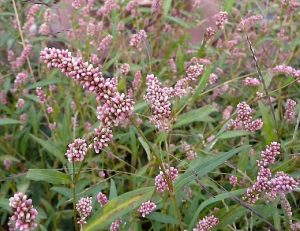
Lady Thumbs are closely related to Smartweed.
Also happily blossoming now is Smartweed, a hot pepper substitute. We saw a lot of it last weekend in a private class in Mayakka City. There are actually two sources of heat on the plant. The leaves have quite a bite. The blossoms are hot and bitter. The blossoms can be white or pink and the plant always grows in damp places if not in water. One odd thing about the species is that it can also be used to catch fish. To read about Smartweed go here. I also have a video about Smartweed, filmed in the rain if I remember correctly. You can view it here.
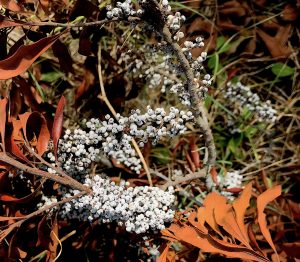
Southern Wax Myrtle berries. Photo by Green Deane
Just because you can do something doesn’t mean you should. Can you make a bayberry candle? Absolutely. Should you? If you have to, yes. If not you might want to reconsider. Southern Wax Myrtle berries are small. They have a little wax on them and why the species name is cerifera — wax producing. But it takes many gallons and a lot of hot work to get enough bayberry wax to mix with tallow (75/25) to make the famous smokeless candle that keeps away insects. No doubt hundreds of years ago it was worth it when folks had tallow from their own cattle, a lot of Bayberries and mosquitoes. Not so much today. You can also put the berries in your candle mold which is far less work. One can use the dried berries as a spice and the leaves like bay leaves or to make a tea. To read more about the Southern Wax Myrtle go here.
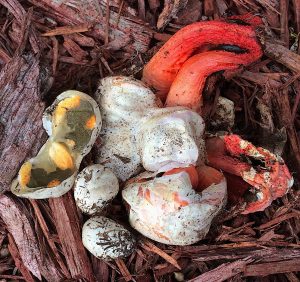
Stinkhorn Mushroom. Photo by Green Deane
There is a strange mushroom you can see this time of year that nearly no one eats, the Column Stinkhorn. It smells like a dead animal, not exactly appetizing. The edibility of the Column Stinkhorn is also debatable. Most list it as not edible and there are reports of sickness in humans eating mature specimens. However, at least one noted expert says when in the egg stage they are mild and edible such as on the left side of the picture. It takes me years of studying a mushroom before I eat it. I think this one needs more study. Their fetid aroma attracts flies which then spread the spores around. Some plants also do that. Pawpaw comes to mind.

Green Deane videos are now available on a USB.
My nine-DVD set of 135 videos has been phased out and replaced by a 150-video USB. The USB videos are the same videos I have on You Tube. Some people like to have their own copy. The USB videos have to be copied to your computer to play. If you want to order the USB go to the DVD/USB order button on the top right of this page or click here. That will take you to an order form. I’d like to thank all of you who ordered the DVD set over the years which required me to burn over 5,000 DVDs individually.

Green Deane Forum
Want to identify a plant? Perhaps you’re looking for a foraging reference? You might have a UFO, an Unidentified Flowering Object, you want identified. On the Green Deane Forum we — including Green Deane and others from around the world — chat about foraging all year. And it’s not just about warm-weather plants or just North American flora. Many nations share common weeds so there’s a lot to talk. There’s also more than weeds. The reference section has information for foraging around the world. There are also articles on food preservation, and forgotten skills from making bows to fermenting food.
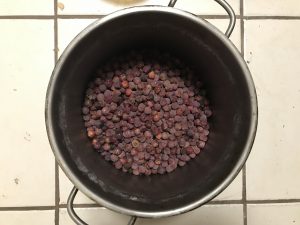
Sea Grapes ready for cooking then fermentation. Photo by Green Deane
My latest country wine adventure is a test gallon of Sea Grape Wine. As most were recovered from the ground they were boiled first and for good measure sulphided as well. The problem with wine making, if there is one, is that it can take years to find out if you were on the right track and the right recipe. That is probably why home winemaking has a less than stellar reputation. The problem with Sea Grapes is they have a unique flavor. When you make them into jelly they lost that unique aspect and taste like apply jelly. I am hoping Sea Grape Wine will taste like Sea Grapes, not apple wine…
We end on a sad note. A hiker in South Carolina, Devin A. Heald, 37, has died from eating Sesbania vesicaria, also called Bagpod. It’s in a group with Crotalaria, most if not all toxic. He ate it while hiking on the afternoon of Tuesday, the 26th of October, and died early in the morning on Thursday the 28th. It is understandably a difficult time for his family and friends. I teach students in my classes to avoid the legume/pea family. While there are notable exceptions almost all the plants in that group are toxic to humans. They do not want to be eaten. The suspected toxins with this species are saponins though I would not be surprised to learn lectins were also involved. The plants are common as they used to be used as an off-year nitrogen fixer, so called green manure. There are numerous reports of them sickening a variety of animals and fowl including chickens, sheep, cattle, hogs, goats and cats. Cattle, unfortunately, develop a taste for them and gain access when put on new pasture with the plants in the fall. Death from this species is brutally painful.
This is my weekly free newsletter #480. If you want to subscribe to this free newsletter you can find the sign-up form in the menu at the top of the page.
To donate to the Green Deane Newsletter click here.

